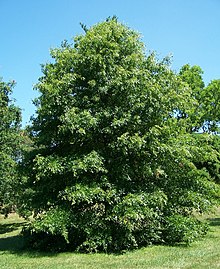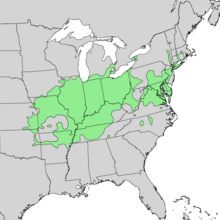Pin Oak
| Pin oak | |
|---|---|
 |
|
| Scientific classification | |
| Kingdom: | Plantae |
| (unranked): | Angiosperms |
| (unranked): | Eudicots |
| (unranked): | Rosids |
| Order: | Fagales |
| Family: | Fagaceae |
| Genus: | Quercus |
| Section: | Lobatae |
| Species: | Q. palustris |
| Binomial name | |
|
Quercus palustris Münchh. 1770 not Regel ex A. DC. 1864 |
|
 |
|
| Synonyms | |
|
|
Quercus palustris, the pin oak or swamp Spanish oak, is an oak in the red oak section Quercus sect. Lobatae. Pin oak is one of the most commonly used landscaping oaks in its native range due to its ease of transplant, relatively fast growth, and pollution tolerance. Its distinctive shape is considered unique among hardwoods.
Quercus palustris is mainly distributed in the eastern and central United States from Connecticut west to eastern Kansas, and south to Georgia, west to eastern Oklahoma and Kansas. It is also native in the extreme south of Ontario, Canada. The pin oak is also well adapted to life in Australia (where it has been introduced) and is quite widespread across the Australian continent especially in the cooler southern States such as Victoria and New South Wales. Is also well adapted to life in Argentina, especially in the Río de la Plata region.
Pin oak grows primarily on level or nearly level, poorly drained alluvial floodplain and river bottom soils with high clay content. Pin oak is usually found on sites that flood intermittently during the dormant season but do not ordinarily flood during the growing season. It does not grow on the lowest, most poorly drained sites that may be covered with standing water through much of the growing season. However, it does grow extensively on poorly drained upland "pin oak flats" on the glacial till plains of southwestern Ohio, southern Illinois and Indiana, and northern Missouri. The level topography and presence of a claypan in the soil of these areas cause these sites to be excessively wet in winter and spring.
It is a medium-sized deciduous tree growing to 18–22 metres (59–72 ft) tall, with a trunk up to 1 metre (3.3 ft) diameter. It has an 8–14-metre (26–46 ft) spread. A 10-year-old tree grown in full sun will be about 8 metres (26 ft) tall. Young trees have a straight, columnar trunk with smooth bark and a pyramidal canopy. By the time the tree is 40 years old, it develops more rough bark with a loose, spreading canopy. This canopy is considered one of the most distinctive features of the pin oak: the upper branches point upwards, the middle branches are perpendicular to trunk, and the lower branches droop downwards.
...
Wikipedia
